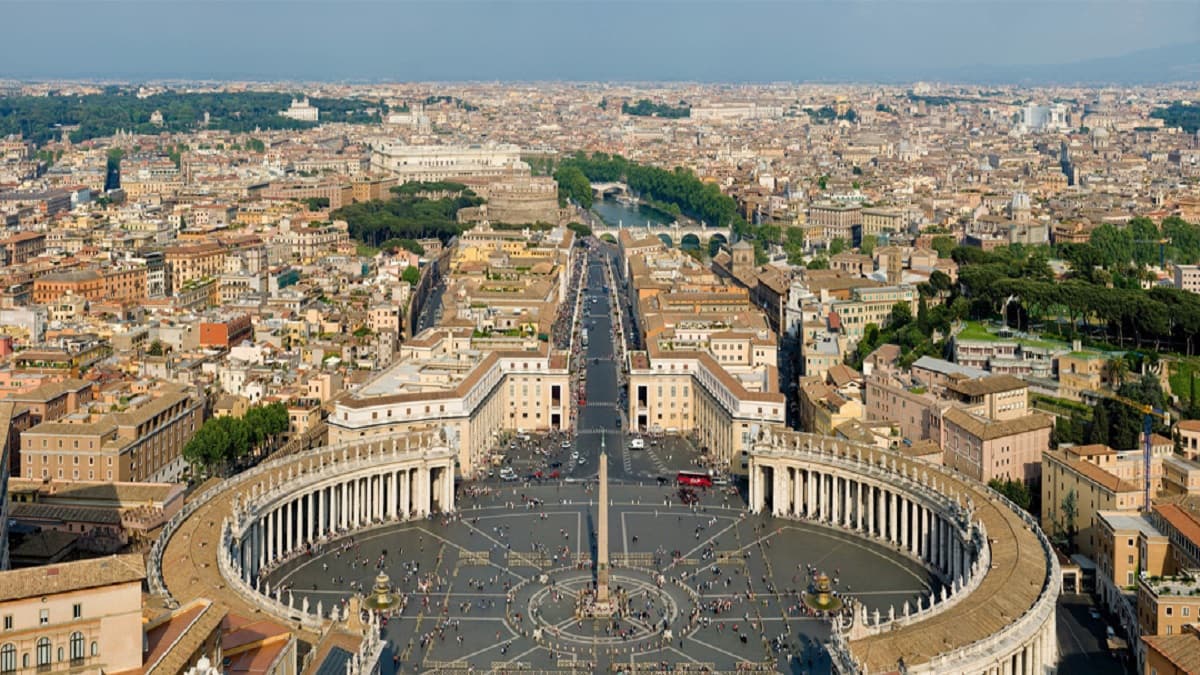Via della Conciliazione connects Castel Sant’Angelo to Piazza San Pietro, where a strip of travertine (joining the Bernini colonnades) defines the confine between two states. It unites the capital of Italy and the City of Seven Hills, with the Vatican City State.
Why is it Named in this Way?
For the Concordat between Italy and the Holy See (the Lateran Pacts 11/2/1929) in which a sovereign state was born, after the loss of the Papal State following Italian unity (20/9/1870). It took 60 years for that rift to heal.
The street (commissioned by Mussolini and Pio XI) was designed by Marcello Piacentini (the regime’s architect) and Attilio Spaccarelli, who created a triumphal access route to the basilica and opened up an extended wider visibility to Michelangelo’s dome.
When Gian Lorenzo Bernini originally created the Colonnade, visitors would reach it crossing narrow alleys and passing by various buildings without being able to perceive its vastness and magniloquence: thus creating an incredible surprise effect upon arrival.
The idea of opening an avenue from the Tiber to the Colonnade in order to give a solemn scenario to the square had been in the air since the seventeenth century, but only Mussolini created it. Starting on October 28th 1936, the demolition of the Borgo district (600,000 m³ of debris) lasted one year: 1,236 families were evicted and relocated to other areas of Rome.
A Fascist Style for a Grandiose Project
The street has honorary entrances at its ends: columns and fountains at the end near Castel Sant’Angelo, two curved brick foreparts towards San Pietro; it is decorated with obelisks in travertine supporting lampposts, inspired by the prestigious Egyptian Vatican prototype.
After the war that delayed construction ended, the works were completed for the 1950 Jubilee.
The enterprise aroused criticism not only for its ideological matrix, a "neoclassical fascist rationalist" style far from the local tradition, but also for having erased almost all of the old quarter near the Passetto and the Renaissance fortified citadel. For the 1500 Jubilee Pope Borgia had created a straight avenue joining the Tiber to the papal palaces: Via Alessandrina, embellished with valuable buildings, but the peculiarity of Borgo has always been the coexistence of humble social housing, elegant private residences, churches, narrow alleys narrow, taverns and shops
The central square, Scossacavalli, was demolished and the fountain was dismantled and moved to Piazza Navona. Churches and houses were destroyed, but some important buildings were saved, dismantled and reassembled in a “fake antique style.”
Borgo: the Beauty to Admire Starting from Piazza San Pietro
Right side coming from San Pietro
Palazzo Armellini Cesi sixteenth century, cardinal. It is open to the public with donations (recommended!).
Palazzo Serristori, of Florentine Renaissance architecture, it was the seat of the Medicean Embassy, today it houses a school. It was saved from the demolition because it looked down Via dei Cavalieri del Santo Sepolcro.
Palazzo dei Penitenzieri Della Rovere
15th century, cardinal, inspired by Palazzo Venezia (lateral tower and Guelph cross windows). It’s interiors were decorated Pinturicchio and externally it has two 17th century fountains with the Borghese coat of arms.
In the '600 it was inhabited by the Penitentiaries of St. Peter, and today it is home to the Equestrian Order of the Holy Sepulchre of Jerusalem, that can be visited by prior arrangement.
Borgo Santo Spirito has a hospital dating back to the Middle Ages that is still active and the "Ruota degli Esposti", - “Wheel of the Exposed” used by women to ‘dispose’ of unwanted children, entrusting them into the care of the Church.
Left side:
Palazzo Rusticucci (demolished and rebuilt) by Bramante, the only original element remaining being the portal. It was inhabited by Raphael from 1517 to his death. Incorporated into the Palazzo dei Convertendi in the 17th century, it is the property of the Holy See.
Palazzo Torlonia, 15th-century cardinal's palace restored in the 1800s with its Renaissance-style façade.
After Palazzo Latmiral (1887), there is S. Maria in Traspontina and finally l’Auditorium della Musica for events of culture and entertainment.

Vox City, The Vox Group's Dedicated Business-To-Consumer Arm For The Past Five Years, Is Staffed By Veteran Travel Industry Experts With A Combined 21 Years Of Expertise In The Tourism Industry. Let's Explore The Beauty Of Travel In Your Own Way At Your Own Pace.
Vox City International 63 Holly Walk | CV32 4JG Leamington Spa
2025 Vox City, All rights reserved.





